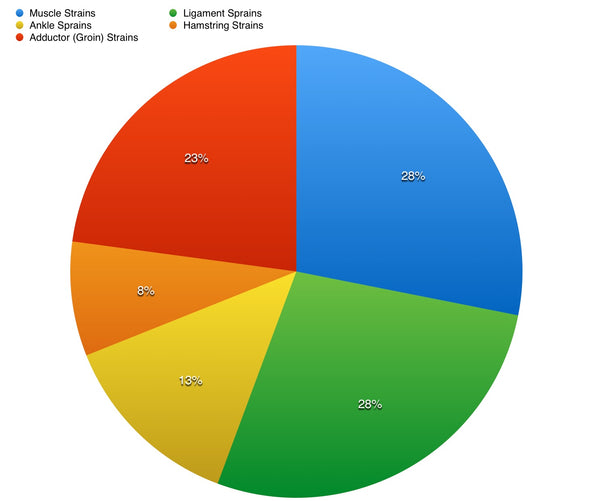Treating Soccer Injuries
Posted by Stuart Hinds on
Treating Gastro/Soleus - Stuart Hinds
Wherever you live or work as a therapist, you are probably surrounded by hundreds, or even thousands of youths who play soccer!
Quite a number of massage/manual therapists have built successful practices by fine-tuning their skills to treat common soccer injuries.
Soccer players are uniquely susceptible to muscle strains and ligament sprains due to the quick changes in direction, lateral movements, pivoting and the rapid accelerations and decelerations involved in the sport.
The ankles, hamstrings, adductors (groin) and other muscles around the hip and thigh are particularly susceptible.

Most Common Soccer Injuries (Source: USYS / NCAA)
Huge Demand
Soccer is the largest participation sport in the world. US Youth Soccer for example, is the largest youth sports organization in the United States, with over 3,000,000 registered players aged 5-19.
Just about wherever you live or work, you are probably surrounded by hundreds or thousands of youths who play soccer.
Honing Your Skills
By learning to understand the specific nature and type of soccer injuries, and honing your skills to address the prevention and treatment of these injuries, you can be assured of a boost to your client base.
Soccer parents meet and talk regularly at practices and games, so if you're good at what you do, you'll be amazed at how quickly word will spread.
Awareness
Parents and coaches are increasingly becoming aware that sports massage therapy can pay off with health benefits for young athletes.
They are also increasingly aware of the benefits and importance of trigger point therapy.
Treating sore muscles
Just like older athletes, youths who participate in soccer experience sore muscles due to overuse.
A regular light massage can help reduce muscle stiffness and prevent common soft-tissue type injuries.

Soccer Injuries by Type (Source: USYC / NCAA)
Holding Patterns
Certainly in almost all cases, the injured young athlete should be examined/treated for satellite trigger points following an injury, to identify trigger points in associated muscles.
These may have developed as a holding pattern in response to the initial injury. Where these trigger points are left untreated, there may be an increased likelihood of other injuries.
Again, youths are no different from adults in this regard, and where the resources are available, treatment of this type will help keep them healthy - which means more time on the field.
Post-Surgical Rehabilitation
Around 1.5% of all youth soccer injuries require surgery. Most of these relate to the knee (MCL, ACL) and all require prologued periods of recovery and rehabilitation.
Manual therapies including trigger point therapy should be part of the rehabilitation process, just as it is for professional athletes, alongside the required physical therapy.
Flexibility and Range of Motion
By identifying and treating trigger points, therapists can pinpoint movement issues.
This is hugely beneficial in terms of potential injury avoidance and improved athletic performance.
Don't underestimate the competitiveness of these young athletes. They and their parents tend to take their sport very seriously!
Treating Runner's Knee Trigger Point Master Class
Treating Hip Pain and Dysfunction Master Course
About the author
Stuart Hinds is one of Australia’s leading soft tissue therapists, with over 27 years of experience as a practitioner, working with elite sports athletes, supporting Olympic teams, educating and mentoring others as well as running a highly successful clinic in Geelong.
Stuart has a strong following of practitioners across Australia and globally who tap into his expertise as a soft-tissue specialist. He delivers a range of highly sought after seminars across Australia, supported by online videos, webinars and one-on-one mentoring to help support his colleagues to build successful businesses.
In 2016, Stuart was awarded a lifetime membership to Massage & Myotherapy Australia for his significant support and contribution to the industry.
This trigger point therapy blog is intended to be used for information purposes only and is not intended to be used for medical diagnosis or treatment or to substitute for a medical diagnosis and/or treatment rendered or prescribed by a physician or competent healthcare professional. This information is designed as educational material, but should not be taken as a recommendation for treatment of any particular person or patient. Always consult your physician if you think you need treatment or if you feel unwell.
Liquid error (sections/article-template line 26): Could not find asset snippets/relatedblogs.liquid